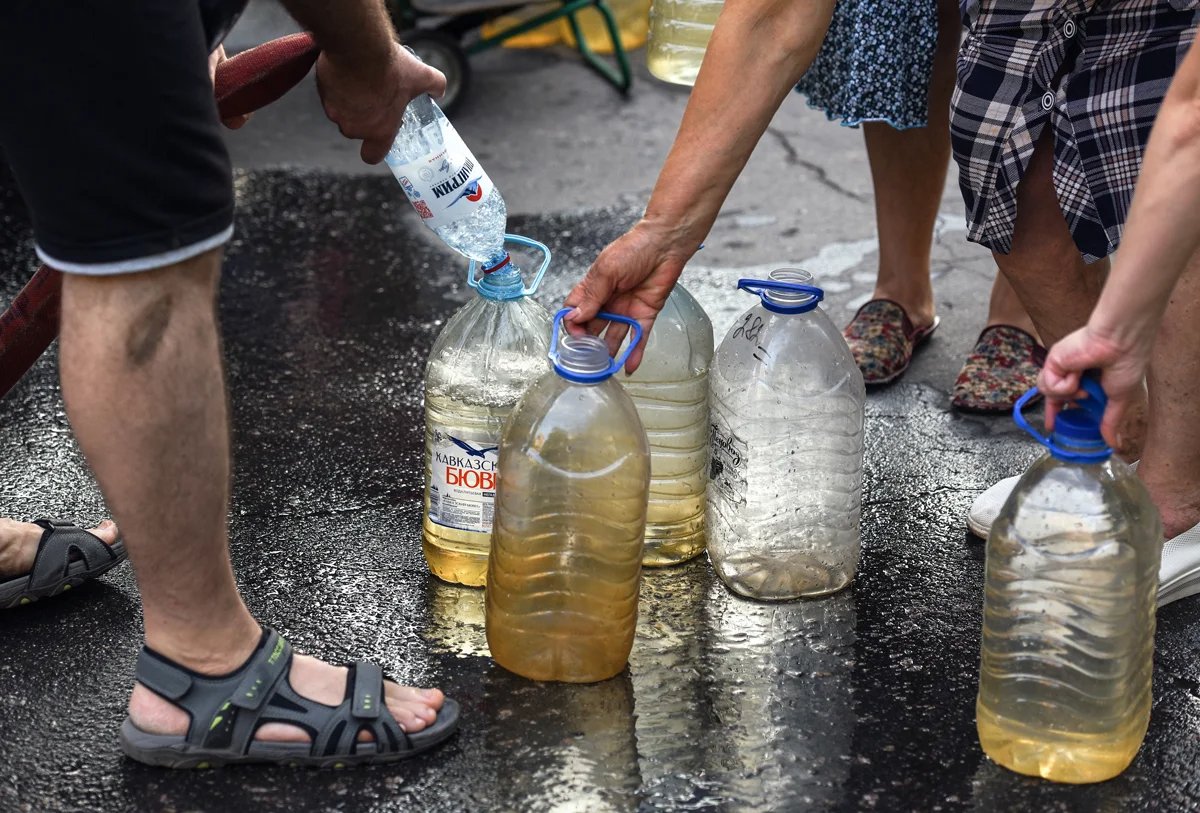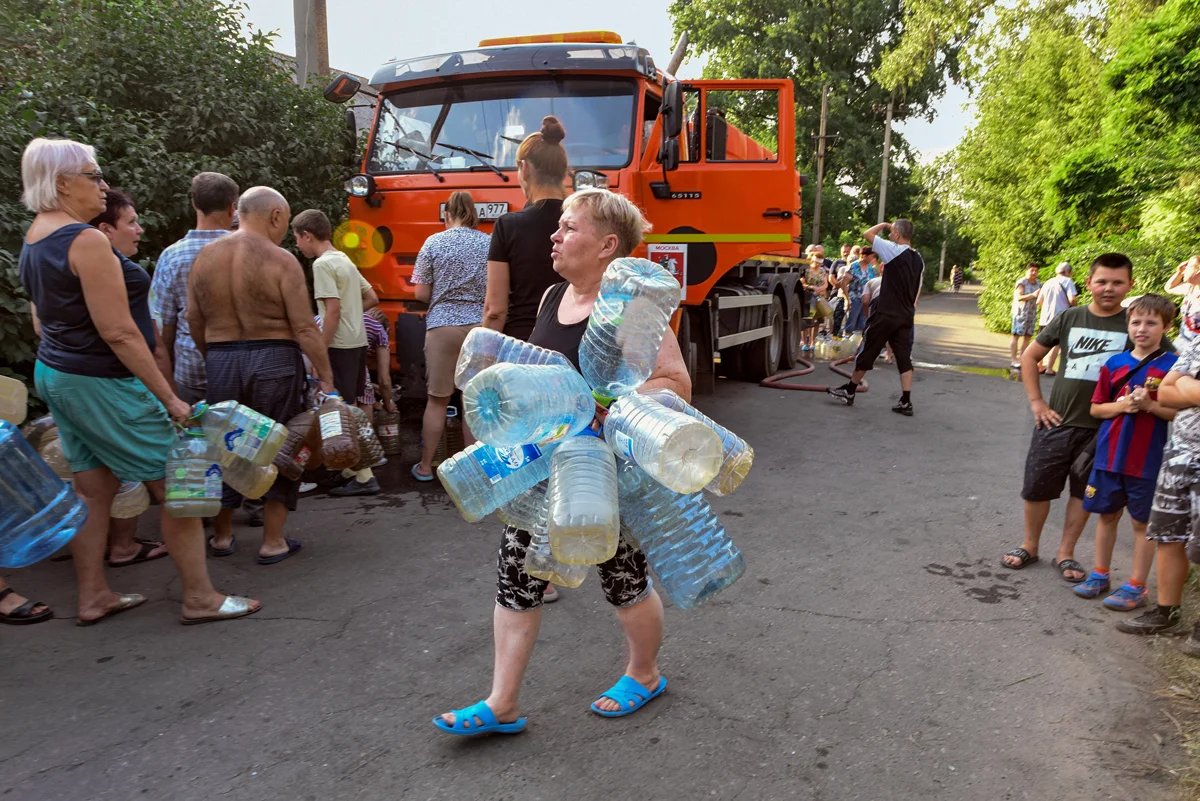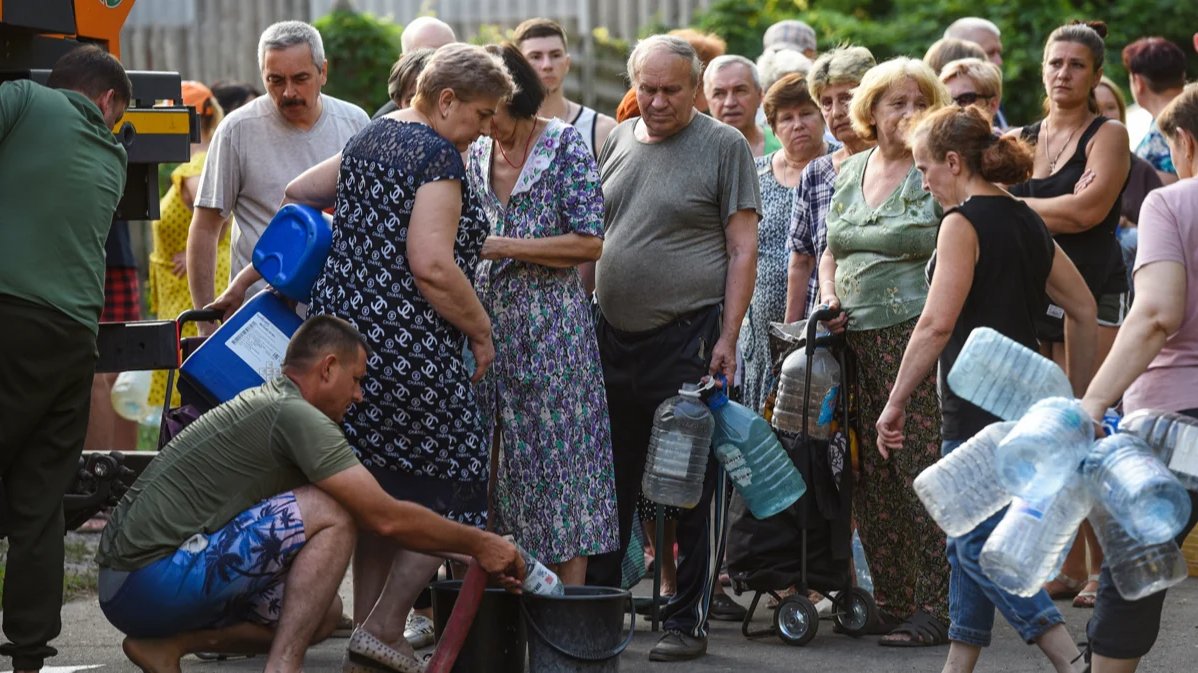Long columns of water tankers sent from southern Russia to occupied eastern Ukraine have become a common sight in Donbas over recent weeks, as scorching hot temperatures have combined with longstanding pipeline transport issues to yield a rapidly deepening water supply crisis that some fear could lead to a mass evacuation.
However, although the tankers, ostensibly organised at the request of the local occupation authorities, may supply enough water to feature in nightly Kremlin-friendly news reports aimed at audiences in Moscow, they deliver nowhere near the amount needed by Donbas residents to sustain daily life.
The steppe region has always been short on fresh water, a problem that has worsened following the expansion of mining, which has destroyed underground aquifers that might have otherwise been able to sustain it. Then, as if the situation wasn’t already critical enough, the Siverskyi Donets–Donbas Canal, built by the Soviet Union in the 1950s, was destroyed at the beginning of the full-scale invasion.
These days, water survival is an art form in Donbas — one mastered best by those who have private homes.
Since 2022, Donbas residents have endured an erratic, ever-lessening water supply, with some households’ taps running only once every four days. Today, as some metallurgical and chemical plants still quietly draw vast quantities of water to continue operating, most locals have been forced to develop adaptation strategies — planning laundry, dishwashing, and bathing days in advance in order to survive.
These days, water survival is an art form in Donbas — one mastered best by those who have private homes. They can dig pit latrines, hide barrels in their gardens, and rig up makeshift tap systems fed from stored supplies. In the new high-rises previously coveted by Donetsk’s rich and prosperous, there is no such fallback, and when scheduled water supply slows it is often residents of those buildings seen waiting for water truck deliveries.

Local residents fill plastic bottles with water, Donetsk, 29 July 2025. Photo: Taisia Vorontsova / Kommersant / Sipa USA / Vida Press
“I have two 500-litre barrels of water in my house and another 1000-litre one in my garden; I filled them up when the water was still flowing,” says Ivan, who lives with his family of five in a small home in Makiivka, east of Donetsk. “Nowadays it may come once every three days, but it’ll barely be a trickle. The last time they turned the water on, it took me three hours to get 100 litres, and we haven’t had more than 200 litres all summer!”
Against European consumption standards of 100 litres per person per day, the two-tonne cache of water enjoyed by Ivan is modest, though these days in Donbas it is a mark of luxury. Many now survive on a fraction of that, drawing cloudy well water or filling buckets from ponds.
“Our neighbors have a well, so we ask them for water. My daughter lives alone and also goes to the neighbours’ well,” says Tetyana, who is from the same town of Makiivka. “What kind of water is in the well? Well water! On weekends, my husband and I drive to the local pond and collect as much water as we can carry for our household.
Even if Russia does one day occupy the entire Donetsk region, it will not be able to re-establish the water supply.
Tetyana does not mention the scheduled water supplies. Her neighborhood in Makiivka is built over an old, shuttered mine, and the homemade wells in the area are seen by many as untrustworthy.
It would take at least three years just to fill the reservoir near the Oskil River, not to mention any others, a manager at Donbas Water, a water supply company that operates in the occupied Donetsk region, tells Novaya Gazeta Europe.
All that remains of the canal is a piece of dry bed captured in 2014 and four large reservoirs created in the late 1950s for short-term emergencies. By late 2022, it was clear that the Russian army could not take Raihorodok and Slovyansk, where the canal began. It had just lost the Kharkiv region and with it the Oskil Reservoir.
Russian Deputy Prime Minister Marat Khusnullin promised to have a water pipeline providing Donetsk with water from the Don installed by March 2023. This was patent nonsense. The Khrushchev-era canal took four years to build, and required 20,000 workers from all over the Soviet Union.

People queueing for water in Donetsk, 29 July 2025. Photo: Taisia Vorontsova / Kommersant / Sipa USA / Vida Press
Servicemen had indeed laid a water pipeline between the Don and the dry section of the canal by June 2023. The Moscow-installed head of the so-called “Donetsk People’s Republic” (DPR), Denis Pushilin, said openly at the time that the water from the Don would not solve the problem, but would make schedules more predictable and guarantee that Donetsk would have a reliable water supply for three hours every third day.
Even at full capacity, the project was only ever designed to provide one eleventh of the minimum water supply through the Siverskyi Donets-Donbas canal. In the last pre-war years, the capacity of the canal, which was expanded in 1979, was about 2.4 million cubic metres per day. The water pipeline from the Don promised by the DPR authorities, on the other hand, was due to provide a mere 288,000 thousand cubic metres per day.
Moscow’s propaganda about a Ukrainian “water blockade” has a whiff of Goebbels about it. There can be no “blockade” when there is no longer a master switch. And even if Russia does one day occupy the entire Donetsk region, it will not be able to re-establish the water supply. The canal would need to be rebuilt, but no one undertakes such monolithic Soviet-style projects any more.
As time has shown, the new authorities are willing to subject the people who have now lived under occupation for 11 years to just about anything.
Russian hype around water supply is therefore particularly disturbing. Vladimir Putin has met Pushilin personally. Children in Donetsk and Makiivka have made video appeals to Putin, while news reports about the lack of water have appeared on prime time TV. But there is no way of resolving the Donbas water problem without Ukraine’s involvement. Tankers running between Rostov-on-Don and Donetsk are enough to fill news stories only.
One solution would be to remove the pesky consumers, and the first fake news stories about possible epidemics and forced evacuations from Donetsk have already appeared. Donetsk already faced one such evacuation in 2022. In a quiet period on the nearby line of contact, the occupying authorities suddenly announced a Ukrainian offensive requiring the urgent evacuation of the population. The following day, mobilisation began. And then came the full-scale war.
But as time has shown, the new authorities are willing to subject the people who have now lived under occupation for 11 years to just about anything.
Join us in rebuilding Novaya Gazeta Europe
The Russian government has banned independent media. We were forced to leave our country in order to keep doing our job, telling our readers about what is going on Russia, Ukraine and Europe.
We will continue fighting against warfare and dictatorship. We believe that freedom of speech is the most efficient antidote against tyranny. Support us financially to help us fight for peace and freedom.
By clicking the Support button, you agree to the processing of your personal data.
To cancel a regular donation, please write to [email protected]

